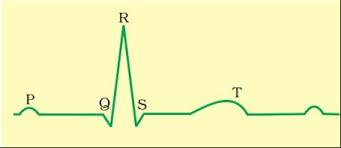
Give the technical term for:-
The instrument used to measure the heartbeat.
Answer
552.9k+ views
Hint: The instrument used to record action potentials generated by heart muscles is called an electrocardiogram or ECG machine.

Complete answer: 1. A graphic record of electrical variations produced by the heart during one heartbeat or cardiac cycle is called an electrocardiogram or ECG.
2. The technique was discovered by Einthoven in 1903 therefore he is called the father of electrocardiography.
3. The electrical activities of the heart are recorded on ECG machines by placing the electrodes at various locations on the body.
4. Two electrodes are connected to the chest of the patient above the heart while the third electrode is a reference connection, connected to the upper and lower limbs.
5. A conducting gel is applied between the skin and electrodes to detect tiny impulses of a few millivolts.
6. The electrical activity of the heart is represented in the form of a graph as time (X-axis) against voltage displacement (Y-axis)
7. A normal ECG is a series of ridges and furrows. It consists of different types of waves such as P-wave, QRS complex, and T-wave.
8. P – wave is a small upward wave representing an impulse generated by a SA node. It causes atrial depolarisation resulting in atrial contraction.
9. The QRS complex represents the spreading of impulse from the SA node to the AV node, then to the bundle of His and Purkinje fibers. It causes ventricular depolarization resulting in ventricular contraction.
10. T – wave is a broad upward wave that represents ventricular repolarization resulting in ventricular relaxation.
So, the correct answer is ECG.
Note:ECG is also useful to detect abnormal functioning of the heart as in coronary artery diseases, heart block, angina pectoris, tachycardia, ischemic heart disease, myocardial infarction, cardiac arrest, etc.

Complete answer: 1. A graphic record of electrical variations produced by the heart during one heartbeat or cardiac cycle is called an electrocardiogram or ECG.
2. The technique was discovered by Einthoven in 1903 therefore he is called the father of electrocardiography.
3. The electrical activities of the heart are recorded on ECG machines by placing the electrodes at various locations on the body.
4. Two electrodes are connected to the chest of the patient above the heart while the third electrode is a reference connection, connected to the upper and lower limbs.
5. A conducting gel is applied between the skin and electrodes to detect tiny impulses of a few millivolts.
6. The electrical activity of the heart is represented in the form of a graph as time (X-axis) against voltage displacement (Y-axis)
7. A normal ECG is a series of ridges and furrows. It consists of different types of waves such as P-wave, QRS complex, and T-wave.
8. P – wave is a small upward wave representing an impulse generated by a SA node. It causes atrial depolarisation resulting in atrial contraction.
9. The QRS complex represents the spreading of impulse from the SA node to the AV node, then to the bundle of His and Purkinje fibers. It causes ventricular depolarization resulting in ventricular contraction.
10. T – wave is a broad upward wave that represents ventricular repolarization resulting in ventricular relaxation.
So, the correct answer is ECG.
Note:ECG is also useful to detect abnormal functioning of the heart as in coronary artery diseases, heart block, angina pectoris, tachycardia, ischemic heart disease, myocardial infarction, cardiac arrest, etc.
Recently Updated Pages
Master Class 11 Economics: Engaging Questions & Answers for Success

Master Class 11 English: Engaging Questions & Answers for Success

Master Class 11 Social Science: Engaging Questions & Answers for Success

Master Class 11 Biology: Engaging Questions & Answers for Success

Class 11 Question and Answer - Your Ultimate Solutions Guide

Master Class 11 Business Studies: Engaging Questions & Answers for Success

Trending doubts
10 examples of friction in our daily life

One Metric ton is equal to kg A 10000 B 1000 C 100 class 11 physics CBSE

Difference Between Prokaryotic Cells and Eukaryotic Cells

1 Quintal is equal to a 110 kg b 10 kg c 100kg d 1000 class 11 physics CBSE

Explain zero factorial class 11 maths CBSE

What is a periderm How does periderm formation take class 11 biology CBSE




